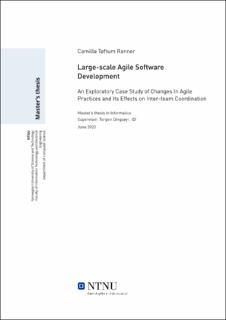| dc.contributor.advisor | Dingsøyr, Torgeir | |
| dc.contributor.author | Ranner, Camilla Tøftum | |
| dc.date.accessioned | 2021-09-15T16:01:51Z | |
| dc.date.available | 2021-09-15T16:01:51Z | |
| dc.date.issued | 2020 | |
| dc.identifier | no.ntnu:inspera:57390197:24491150 | |
| dc.identifier.uri | https://hdl.handle.net/11250/2777496 | |
| dc.description.abstract | Smidige metodikker ble opprinnelig laget for mindre IT-prosjekter bestående av ett team. I de senere årene har smidige metodikker også blitt brukt på prosjekter i stor skala. Dette har forårsaket store smidige prosjekter til å møte på flere utfordringer, hvor koordinering mellom team er en av de største utfordringene. Da storskala smidige IT-prosjekter blir stadig mer vanlig, og det er funnet manglende forskning på koordinering mellom team i en slik kontekst, vil denne masteroppgaven se nærmere på dette temaet. Forskningsspørsmålet for denne masteroppgaven er «Hvordan er koordinering mellom team påvirket av endring i smidig metodikk?».
En eksplorativ casestudie ble valgt som forskningsstrategi, hvor det valgte caset var et storskala smidig IT-prosjekt i en offentlig skandinavisk velferdsorganisasjon. Prosjektet ble delt opp i tre faser, hvor arbeidsmetodikken endret seg gjennom prosjektet, fra en «water-scrum-fall» metodikk i den første fasen, til å jobbe med autonome og kryssfunksjojelle team, med kontinuerlige leveranser i den siste fasen.
Resultatene fra denne casestudien er basert på 37 intervjuer og dokumentasjon fra prosjektet. Intervjuene ble gjennomført av forskere fra SINTEF, Universitetet i Oslo, og forfatteren av denne masteroppgaven, i perioden desember 2017 til februar 2020. Resultatene ble analysert ved å bruke en teoretisk modell rundt koordineringsmoduser av Ven et al. (1976), og ble brukt til å sammenligne hvordan kvordineringsmodusene ble påvirket av endring av smidig metodikk.
Resultatene viste at i den første fasen, var gruppemodus mest brukt, fulgt av personlig modus, og deretter upersonlig modus. I den siste fasen var det en stor økning i bruken av personlig modus, en nedgang i bruk av planlagte møter og en økning i spontane møter innenfor gruppemodus, og upersonlig modus hadde en nedgang i bruk.
Det ble funnet manglende forskning som kan støtte opp om funnene i den siste prosjektfasen av caset. Det anbefales å gjennomføre mer forskning på koordinering mellom team i IT-prosjekter med autonome, kryssfunksjonelle team og kontinuerlige leveranser. | |
| dc.description.abstract | Agile methodologies were initially created for smaller single-team projects. However, in later years, agile methodologies have also been applied to larger software development projects. This has caused large-scale agile software development projects to face multiple challenges, with inter-team coordination as one of the most prominent challenges. As large-scale agile development projects are becoming more common, and there is found to be a lack of research related to inter-team coordination within this field, this thesis aims to explore this topic further. The stated research question for this thesis is "How is inter-team coordination affected by the change of agile methodology?". An exploratory case study was chosen as research strategy, where the investigated case was a large-scale agile software development project within a public Scandinavian welfare organization. The project was divided into three phases, where the working methodology changed throughout the project from a "water-scrum-fall" approach in the first phase to working with autonomous and cross-functional teams, and continuous deliveries in the last phase. The results from this case study is based upon 37 interviews and documentation from the investigated project. The interviews were conducted by researchers from SINTEF, University of Oslo, and the thesis author, in the period of December 2017 to February 2020. The results were analyzed by using a theoretical framework on coordination modes by Ven et al. (1976), and used to compare how the coordination modes were affected by the change of agile methodology. The findings showed that within the first phase, group mode of coordination were mostly used, followed by personal mode and then impersonal mode. In the last phase it was found to be a large increase in the use of personal mode, a decrease of scheduled meetings and an increase of unscheduled meetings within group mode, while impersonal mode decreased. There was found a lack of similar research that could substantiate the findings from the last project phase in this case. It is recommended that more research is conducted on inter-team coordination in projects with autonomous- and cross-functional teams, and continuous deliveries. | |
| dc.language | | |
| dc.publisher | NTNU | |
| dc.title | Large-scale Agile Software
Development: An Exploratory Case Study of Changes In Agile
Practices and Its Effects on Inter-team Coordination | |
| dc.type | Master thesis | |
